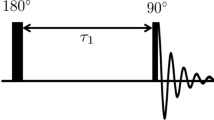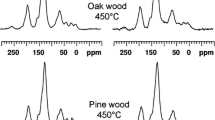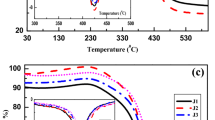Abstract
The abnormal gush of hydrogen sulfide threatens the safety of mining. At present, there is no method and index to predict the enrichment area of hydrogen sulfide. Two coal samples (with or without magnesium sulfate added) were used in pyrolysis experiment, the temperature of two samples at 300℃ is the critical temperature for the generation of hydrogen sulfide gas, and it is also the temperature at which the magnetic susceptibility of the samples increases rapidly, the production of hydrogen sulfide is positively correlated with the high magnetic susceptibility of the sample during coal pyrolysis, therefore the zones with high magnetic susceptibility may be the rich area of hydrogen sulfide in coal field, and the magnetic susceptibility may be used to delineate the abnormal area of hydrogen sulfide. The magnetic susceptibility of coal at 51–138 (unit: 10− 7 SI) may be used to critical value for predicting abnormal zone of hydrogen sulfide in coal bed.




Similar content being viewed by others
Data availability
The data used to support the findings of this study are available from the corresponding author upon request.
References
Alessandro DW, Kyriakopoulos K (2013) Preliminary gas hazard evaluation in Greece. Nat Hazards 69(7):1987–2004
Casagrande DJ, Gronli K, Sutton N (1979) The distribution of sulfur and organic matter in various fractions of peat: origins of sulfur in coal. Geochim Cosmochim Acta 44(5):25–32
Chambers LA, Trudinger PA (1979) Microbiological fractionation of stable sulphur isotopes: a review and critique. Geomicrobiology 1(3):249–293
Cross MM, Manning DA, Bottrell SH, Worden RH (2004) Thermochemical sulphate reduction (RST): experimental determination of reaction kinetics and implications of the observed reaction rates for petroleum reservoirs. Org Geochem 35(4):393–404
Cui JY, Jiao HG, Chen QR, Zhan–Xu T, Zhang CG (2008) Research on relationship of coal specific magnetization ratio varied with coal ash content. Coal Eng 08:93–95
Dai S, Ren D, Tang Y, Shao L, Li S (2002) Distribution, isotopic variation and origin of sulfur in coals in the Wuda coalfield, Inner Mongolia, China. Int J Coal Geol 51(4):237–250
Deng Q (2015) Study on hydrogen sulfide generation model and abnormal enrichment control factors of Jurassic coal seams in the middle part of the southern margin of Junggar Basin. (Doctoral dissertation, Henan Polytechnic University)
Deng Q, Wei J, Li H, Wang Y, Wu X, Liu M (2019) Hydrogen sulfide accumulation factors in coal mine of southeastern margin of junggar basin in China. Appl Ecol Environ Res, (1), 331–322
Deng Q, Zhang T, Zhao F, Wang H, Yin J (2020) The influence of hydrogeology to generation of hydrogen sulfide of low-rank coal in the southeast margin of junggar basin, China. Geofluids 2020(5):1–10
Deng Q, Du Y, Yang Y (2021) Simulation Experiment of TSR Promotes Cracking of Coal Generation H2S. Geofluids, 2021(4), 1–8
Desrocher S, Hutcheon I, Kirste D, Henderson CM (2004) Constraints on the generation of H2S and CO2 in the subsurface Triassic, Alberta Basin. Can Chem Geol 204(3–4):237–254
Fu XH, Wang WF, Yue JH, Wang F, Cui ZJ (2006) Genesis analyses of H2S gas abnormity in gas of Bayi Coal Mine in Zaozhuang. J China Coal Soc 31(2):206–210
Gao K, Jiang M, Guo C, Zeng Y, Fan C, Zhang J (2019) Reductive dissolution of jarosite by a sulfate reducing bacterial community: secondary mineralization and microflora development. Sci Total Environ 690(10):1100–1109
Garcia–Arriaga V, Alvarez–Ramirez J, Amaya M, Sosa E (2010) H2S and O2 influence on the corrosion of carbon steel immersed in a solution containing 3 M diethanolamine. Corros Sci 52(3):2268–2279
Ghazy EA, Mahmoud MG, Asker MS, Mahmoud MN, Sami MEA (2011) Cultivation and detection of sulfate reducing bacteria (SRB) in sea water. J Am Sci 7(2):604–608
Ide TS, Crook N, Orr FM (2011) Magnetometer measurements to characterize a subsurface coal fire. Int J Coal Geol 87(3):190–196
Li J (2020) Research on concealed fire detection of coal seam in Nalinmiao mine based on magnetic property of coal and rock. (Doctoral dissertation, Xi’an University of science and technology)
Lindqvist JK, Hatherton T, Mumme TC (1985) Magnetic anomalies resulting from baked sediments over burnt coal seams in southern New Zealand. New Z J Geol Geophys 28(3):405–412
Liu Q (2005) Quantifying grain size distribution of pyogenic magnetic particles in Chinese loess and its significance for pathogenesis. J Geophys Research: Solid Earth 110(B11):271–283
Liu M, L., Hani M (2011) Genesis modes discussion of H2S gas in coal mines. J China coal Soc 36(06):978–983
Liu L, Miao C, Qiu Y, Party NG (2017) Delineation of spontaneous combustion boundary in the burning area of inan coal field in Yili basin by using high–precision magnetic measurement method. Mod Min 33(10):48–51
Liu X, Xu F, Shi L (2021) Hydrochemical characteristics and indication of groundwater in Wudong coal mine. Coal Eng 53(04):115–119
Loy A, Lehner A, Lee N, Adamczyk J, Meier H, Ernst J (2002) Oligonucleotide microarray for 16SRMA gene–based detection of all recognized lineages of sulfate–reducing prokaryotes in the environment. Appl Environ Microbiol 68(10):5064–5081
Luo Y, Bai X (2005) Distribution of sulfur in coals of China. Coal Convers 2005(283):14–18
Machel HG (2017) Bacterial and thermochemical sulfate reduction in diagenetic settings old and new insights. Sed Geol 140(7):143–175
Robert R (2006) Sulfur isotope geochemistry of sulfide minerals. Reviews in Mineralogy and Geochemistry. Mineralogy Geochem 61(1):633–677
Smith JW, Gould KW, Rigby D (1981) The stable isotope geochemistry of Australian coals. Org Geochem 3(4):111–131
Wang M (2013) Transformation and interaction of sulfur and nitrogen during pyrolysis of typical high–sulfur coal. (Doctoral dissertation, Taiyuan University of technology)
Wang L, Liu L, Guo Z (2006) The discussion of the origin of sulfureted hydrogen in associated gas of Daqing Placanticline. Nat Gas Geoscience 17(1):51–54
Wu J (2019) Thermal Genesis simulation and adsorption mechanism of H2S in coal. (Doctoral dissertation, China University of mining and technology, Xuzhou)
Xue J (2017) The bacterial sulfate reduction and thermochemical sulfate reduction reason research of abnormal hydrogen sulfide anomaly in coal mine of Wudong. (Doctoral dissertation, China University of mining and technology (Xuzhou))
Zhang P (2019) Origin of hydrogen sulfide in the Ediacaran and Cambrian in the central Sichuan basin. (Doctoral dissertation, Chinese University of Petroleum (Beijing))
Zhang X, Chen Z, Liu H, Guo S, Chen K (2000) Effect of environment factors on the growth of sulfate–reducing bacteria. J Chin Soc Corros Prot, (04), 224–229
Zhang JJ, Wei HY, Ren ZQ (2001) Kinetics model of thermal decomposition reaction of aluminum potassium sulphate. Chin J Inorg Chem 17(2):219–234
Zhang S, Shuai Y, He K (2012) Research on the initiation mechanism of thermochemical sulfate reduction(TSR). Acta Petrologica Sinica 28(03):739–748
Zhou LP, Oldfield FA, Wintle AG, Robinson SG, Wang JT (1990) Partly pedogenic origin of magnetic variations in Chinese loess. Nature 346(4):737–739
Zhu G, Zhang S, Liang Y, Ma Y, Zhou G (2006) Distribution of high H2S –bearing natural gas and evidence of TSR origin in the Sichuan basin. Acta Geologica Sinica, 2006(08), 1208–1218
Zhu GY, Zhang SC, Liang YB (2007) The controlling factors and distribution prediction of H2S formation in marine carbonate gas reservoir, China. Chin Sci Bull, (S1): 115–125
Acknowledgements
This work was supported by the National Basic Research Program of China. The author thanks Dr. Junjie Wei from Henan Polytechnic University for conducting some experiments.
Author information
Authors and Affiliations
Contributions
Fajun Zhao: conceptualization, methodology, experiment, and writing.
Corresponding author
Ethics declarations
Ethical approval
Ethical approval was obtained from the Research Ethics Committee of Henan Polytechnic University.
Consent to participate
Not applicable.
Competing interests
The authors declare no competing interests.
The author declares that he have no competing financial interests.
I am employed by Henan Polytechnic University on July 1, 2008, and I declare the following on the conflict of interest: I promise to avoid conflicts of interest (even superficial conflicts) with the university, its shareholders and its customers. A kind of I undertake to ensure that my personal conduct is in accordance with the following guidelines and to report appropriately when there is a potential for actual or potential conflict. These conflicts of interest may be caused by my immediate family members, other members of my family or stakeholders.
This research is supported by National Basic Research Program of China and may lead to the development of products that may have been licensed by National Basic Research Program of China. I have fully disclosed these interests and have developed a plan to manage any potential conflicts that may arise from such an arrangement.
According to policy as well as my moral obligation, I have been to Henan Polytechnic University fully revealed these interests, and I have worked out a plan for approval to manage any potential conflicts caused by the participation.
Additional information
Communicated by H. Babaie.
Publisher’s Note
Springer Nature remains neutral with regard to jurisdictional claims in published maps and institutional affiliations.
Rights and permissions
Springer Nature or its licensor (e.g. a society or other partner) holds exclusive rights to this article under a publishing agreement with the author(s) or other rightsholder(s); author self-archiving of the accepted manuscript version of this article is solely governed by the terms of such publishing agreement and applicable law.
About this article
Cite this article
Zhao, F. Mechanism of using magnetic susceptibility to predict hydrogen sulfide abnormal zone in coalfield. Earth Sci Inform (2024). https://doi.org/10.1007/s12145-024-01299-2
Received:
Accepted:
Published:
DOI: https://doi.org/10.1007/s12145-024-01299-2




